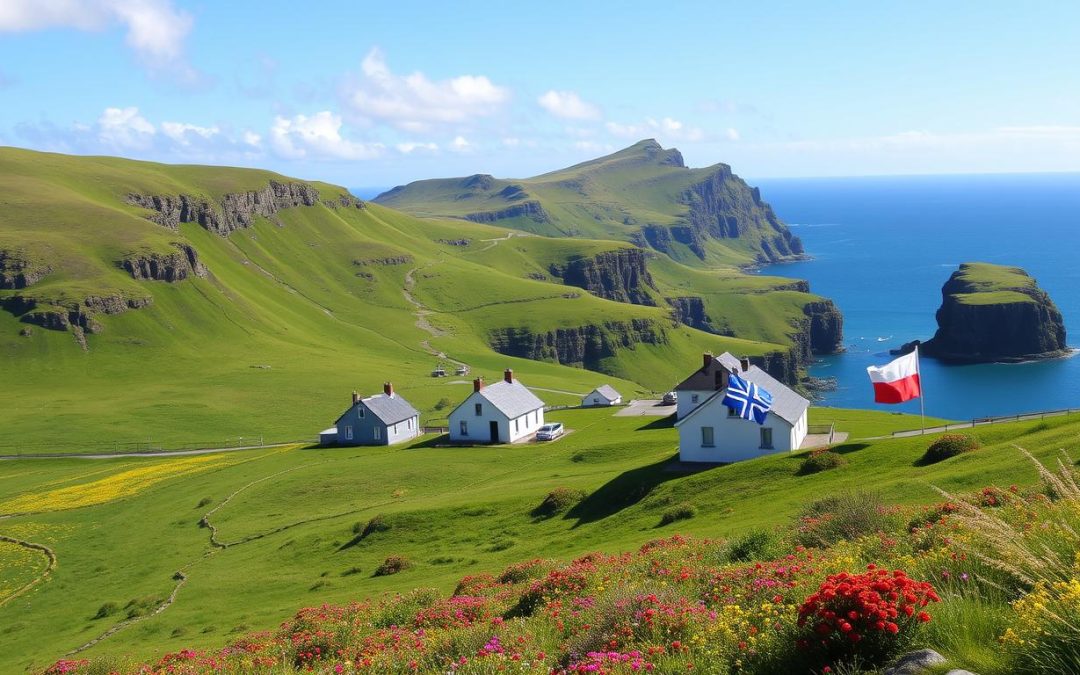Ever wondered how a small Nordic archipelago keeps its language alive in today’s world? The Faroe Islands show us how to preserve language in a globalized world.
In the North Atlantic, the Faroe Islands have a special language scene. Faroese is the main language, spoken by about 45,361 people, or 90.8% of the population. This shows the strength of their culture and pride in their language.
Danish is the second official language, showing the islands’ ties to Denmark. This mix of languages enriches their culture, blending old traditions with new ways of talking.
Exploring the Faroe Islands’ language world, you’ll see how they’ve kept their language alive. They’ve created a lively place where old and new ways of speaking meet.
Key Takeaways
- Faroese is the primary language spoken by over 90% of the population
- Danish remains an official language with administrative significance
- The Faroe Islands maintain a unique linguistic identity
- Linguistic preservation is a crucial aspect of cultural heritage
- Multilingualism reflects the islands’ complex historical background
Historical Development of Languages in the Faroe Islands
The Faroe Islands’ language history is a captivating story. It shows how different cultures mixed, creating a unique multilingual society. This journey starts with the Norse settlers in the 9th century. They brought a language that changed the islands forever.
Early Settlement and Norse Influence
Norse settlers came in the 9th century, bringing West Norse language. This was a key moment for the Faroe Islands’ language. It set a foundation that lasted for centuries.
- Settlements established around 600 AD
- West Norse language became dominant
- Linguistic roots deeply embedded in Norse traditions
Impact of Irish Monks and Celtic Heritage
Before the Norse came, Irish monks had visited the islands. They left a lasting mark on the language. You can see Celtic influence in certain words, showing the area’s rich language diversity.
“Language is the road map of a culture. It tells you where its people come from and where they are going.” – Rita Mae Brown
Language Evolution from 9th to 15th Centuries
Between the 9th and 15th centuries, Faroese language evolved a lot. It started to differ from Old West Norse, becoming its own distinct language.
This period saw Faroese grow apart from other Norse dialects. It also kept complex grammar, making Faroese special.
The Faroese Language: Structure and Origins
Faroese is a unique language in the Scandinavian family. It comes from Norse roots and has kept its special traits over the years. This has made it a treasure of cultural heritage.
This language is closely tied to Icelandic and Middle Norwegian. It started with the West Norse language brought by Norse settlers in the 9th century. Today, it has about 75,000 speakers, showing its importance in preserving language.
- Evolved from West Norse language
- Closely related to Icelandic
- Developed a unique 29-letter alphabet
Experts love Faroese for its complex grammar. It has four main cases:
- Nominative
- Accusative
- Dative
- Genitive
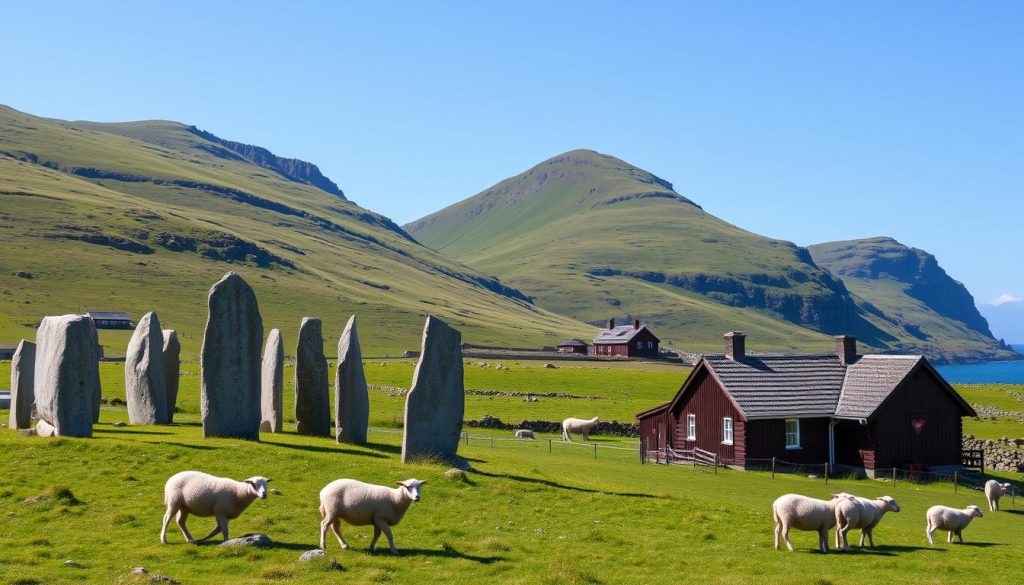
In 1846, Venceslaus Ulricus Hammershaimb created the modern spelling of Faroese. This was a big step for the language. But, it’s hard to learn because of its tricky sounds and letters.
“Faroese is not just a language, but a living testament to the cultural resilience of the Faroe Islands.” – Linguistic Scholars
| Language Characteristic | Details |
|---|---|
| Total Speakers | 75,000 worldwide |
| Primary Regions | Faroe Islands, Denmark, Iceland |
| Language Family | North Germanic (Scandinavian languages) |
Interestingly, Faroese is very similar to Icelandic in writing. This shows the strong bond between Nordic languages.
Danish Influence and Language Preservation
The Faroe Islands have a rich linguistic history tied to Danish influence. After the Reformation in 1540, Danish administrative practices put pressure on the Faroese language. Yet, Faroese showed great resilience as a minority language.
Danish Administrative Period
During the Danish rule, Danish dominated official talks. Government, education, and church services were in Danish. This pressure threatened the Faroese language, making it seem like it might disappear.
- Danish was the primary language of administration
- Official documents were written in Danish
- Education was conducted exclusively in Danish
- Faroese was primarily a spoken language during this time
Modern Language Revival
Efforts to save the Faroese language began as a response to Danish rule. Linguists and cultural activists worked hard to document and standardize Faroese. Venceslaus Ulricus Hammershaimb’s development of a standardized orthography in 1846 was a key moment in Faroese history.
“Language is the roadmap of a culture. It tells you where its people come from and where they are going.” – Rita Mae Brown
Current Status of Danish in the Faroe Islands
Today, the Faroe Islands have a unique language scene. Faroese is the main language, but Danish is also important. About 50,000 islanders speak Faroese first, with Danish used in education and administration.
The journey of preserving the Faroese language shows how a minority can protect its culture against big challenges.
Faroe Islands: Official and widely spoken languages
The Faroe Islands have a rich language scene. Faroese is the main language, spoken by 90.8% of people. About 45,361 people speak it first.
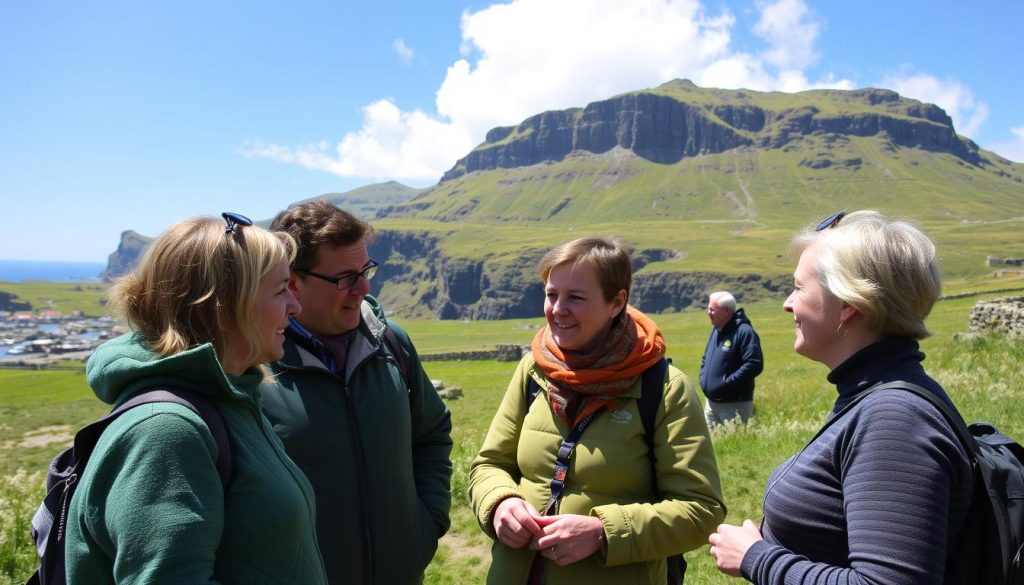
The language scene in the Faroe Islands is interesting. Faroese is key, but Danish is also official. This mix comes from the islands’ ties to Denmark.
- National Language: Faroese (90.8% of population)
- Official Second Language: Danish
- First Language Speakers:
- Faroese: 45,361 speakers
- Danish: 1,546 speakers (3.1%)
English is also big in the Faroe Islands. It’s been taught in schools since the 1970s. People under 60 usually speak English well.
“Our language reflects our identity and connection to our Nordic roots.” – Traditional Faroese saying
| Language | Speakers | Percentage |
|---|---|---|
| Faroese | 45,361 | 90.8% |
| Danish | 1,546 | 3.1% |
| English | 190 | 0.3% |
Schools help keep language diversity alive. Danish is still taught because of its official status. This keeps the Faroese language strong in younger generations.
Modern Linguistic Landscape and Demographics
The Faroe Islands are a unique example of a multilingual society. With only 54,900 people, the language scene is both close and complex.
Let’s dive into the special population and language traits of this North Atlantic community:
- Total population: Approximately 54,900 (2025 estimate)
- Global Faroese speakers: Estimated 80,000 worldwide
- Urban population: 43.2%
- Rural population: 56.8%
Population Statistics and Language Distribution
The Faroe Islands’ language scene is rich and diverse. Faroese is the main language, but Danish and immigrant languages also play a role.
“Language is the roadmap of a culture. It tells you where its people come from and where they are going.” – Rita Mae Brown
Minority Languages and Immigrant Communities
Despite its small size, the Faroe Islands embrace linguistic diversity. Immigrant groups add to the mix, making it a lively multilingual place. Men mostly have Scandinavian roots (87%), while women have Celtic ancestry (84%). This shows the islands’ rich cultural mix.
Efforts to keep Faroese alive ensure the language stays vibrant, even with a small population.
Written Faroese and Hammershaimb’s Legacy
Explore the world of language preservation and meet V.U. Hammershaimb. Born in 1819, he changed the Faroese language from spoken to written. His work was key in making Faroese a standard written language.
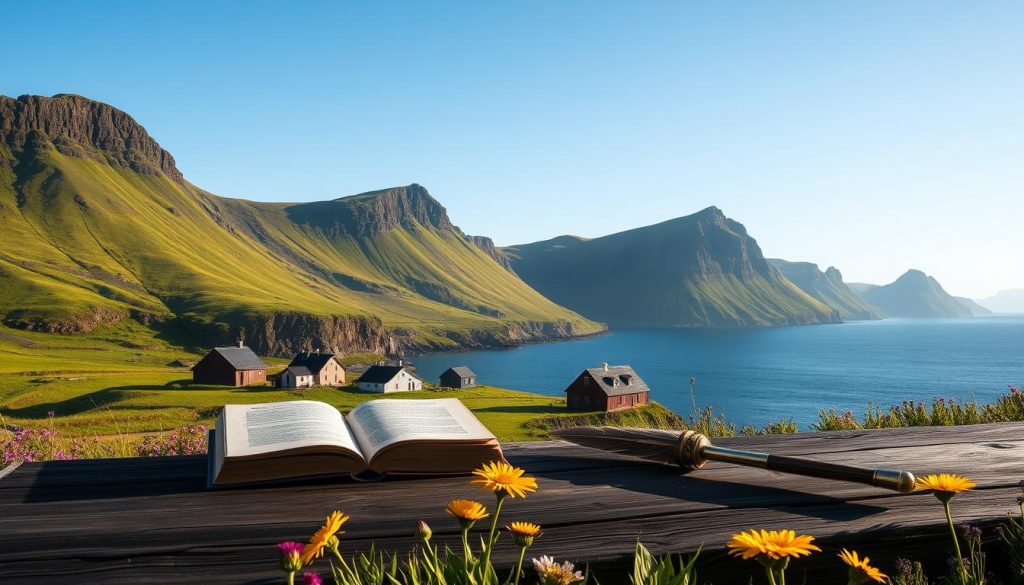
In 1846, Hammershaimb created a new way of writing Faroese. This new orthography became the base of modern Faroese. It kept the language’s unique North Germanic features and Norse roots.
“Language is the road map of a culture. It tells you where its people come from and where they are going.” – Rita Mae Brown
- Published Faroese Orthography in 1846
- Standardized written Faroese grammar
- Preserved over 75,000 ballads and tales
- Recognized dialects across the Faroe Islands
Hammershaimb did more than write. He also studied different dialects. He found variations in southern, northern, and Streymoy dialects. This made the language more authentic and meaningful.
| Year | Linguistic Milestone |
|---|---|
| 1846 | Orthography Publication |
| 1854 | Faroese Grammar Publication |
| 1937 | Official Language Recognition |
Today, Hammershaimb’s work still guides efforts to save languages. His efforts made sure Faroese stays alive. It shows the strength of culture and language.
Language Education and Policy
Language education in the Faroe Islands is complex. It aims to keep Scandinavian languages and culture alive. Schools use detailed policies and methods to teach these languages.
School System Language Requirements
Faroese schools teach students in three main languages. This helps them understand both their local culture and the world beyond.
- Faroese as the primary language of instruction
- Danish as a required second language
- English for global communication
University Level Language Studies
The University of the Faroe Islands, Fróðskaparsetur Føroya, was founded in the 1960s. It started with Faroese courses and now offers more language and research programs.
| Language Program | Focus Area | Significance |
|---|---|---|
| Faroese Language Studies | Linguistic Research | Preserving Cultural Heritage |
| Comparative Nordic Languages | Scandinavian Linguistics | Regional Language Understanding |
“Language is the roadmap of a culture. It tells you where its people come from and where they are going.” – Rita Mae Brown
The Faroe Islands focus on language diversity and education. This shows their strong commitment to their culture and language in a global world.
Digital Age and Language Technology
The Faroe Islands are using technology to save their indigenous language. Digital tools are helping the Faroese language grow in today’s world. With about 54,000 speakers, they’re working hard to keep their language alive.
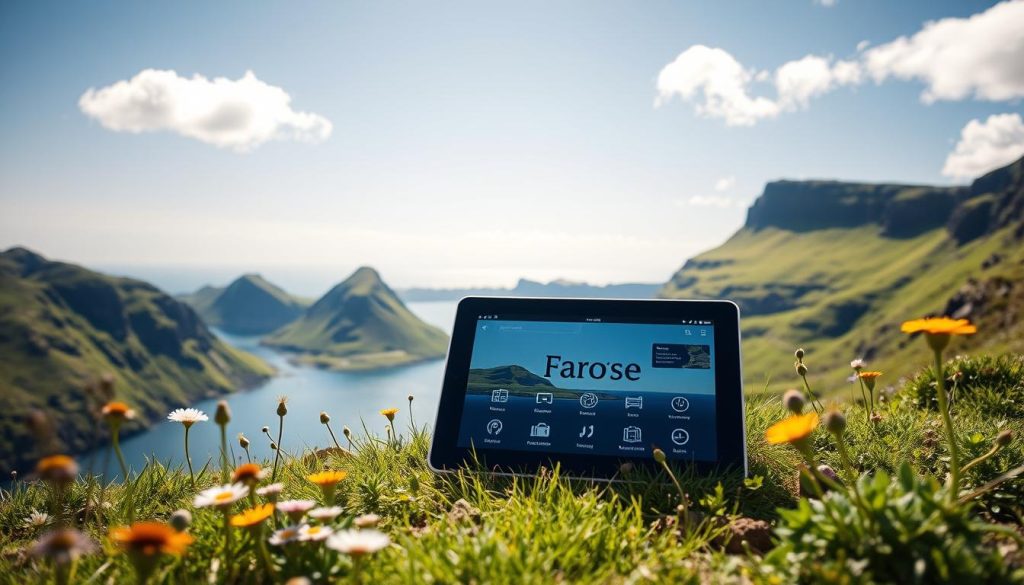
Digital tools are key for the Faroese language’s future. There are big challenges:
- Only 1% of language technology resources are available compared to English
- Digital Language Equality (DLE) score: 718 for Faroese versus 78,257 for English
- 10% of existing language models support less-resourced languages
The Faroe Islands Translate service is a new way to save the language. It lets users hear native Faroese speakers. This helps keep the language real and true.
“Technology is our ally in keeping our language alive and relevant” – Faroese Language Technology Initiative
Big changes are coming:
- 25% more funding for language technology
- 60% of people use Faroese online
- Municipal efforts to grow digital language resources
| Digital Language Metric | Current Status | Future Goal |
|---|---|---|
| Government E-Services in Faroese | 35% | 60% |
| Young Speakers Online Engagement | 45% | 70% |
| Annual Language Resource Growth | Baseline | 50% Increase |
The future of the Faroese language looks bright. Technology is connecting tradition and innovation.
Cultural Impact and Language Preservation Efforts
The Faroe Islands have a rich linguistic heritage. It thrives through vibrant cultural expressions. Your journey into the Faroese language shows a deep commitment to keeping languages and cultures alive.
Media and Broadcasting
The Faroese Broadcasting Corporation is key in keeping the language alive. They broadcast mostly in Faroese, making it relevant today. They also celebrate Mother Language Day every year, showing their dedication to language preservation.
- 100% of local broadcasts are in Faroese
- Annual Mother Language Day events
- Digital platforms supporting language engagement
Literature and Arts
Faroese literature has grown a lot in 200 years. Writers and poets have turned the language into a rich written art form. The creative scene includes:
- Traditional ballads
- Contemporary novels
- Modern poetry collections
“Language is the road map of a culture. It tells you where its people come from and where they are going.” – Rita Mae Brown
The Faroese artistic community keeps the language fresh. They create new words and expressions. Their hard work ensures the language stays vibrant for generations to come.
Conclusion
The Faroese language is a symbol of cultural strength. It has about 75,000 speakers worldwide. This language is more than just a way to talk; it’s the heart of the Faroe Islands.
Despite being a minority language, it keeps growing. It’s a big part of life for almost everyone on the 18 islands. This shows how strong the language is.
Learning about the Faroese language tells a story of pride and protection. It has overcome Danish rule to become the main language in schools and daily life. Now, it’s a lively way to express culture.
The language’s complex rules and sounds make it special. It connects families and keeps the islands’ culture alive. This makes Faroese a treasure for the people.
The future of Faroese looks bright. Schools, media, and communities are working hard to keep it alive. They make sure it stays connected to the islands’ history.
This effort shows the importance of preserving language. It’s not just about talking; it’s about keeping a culture alive. For the Faroese, their language is their spirit and strength.
The above is subject to change.
Check back often to TRAVEL.COM for the latest travel tips and deals.
Here are some Tours & Sightseeing suggestions that might pique your interests!
